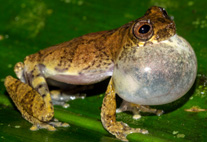Abstract
Many Amazonian frog species that are considered widely distributed may actually represent polyspecific complexes.. A minute tree frog from the Guiana Shield originally assigned to the allegedly widely distributed Dendropsophus brevifrons proved to be a yet undescribed species within the D. parviceps group. We herein describe this new species and present a phylogeny for the D. parviceps group. The new species is diagnosed from other Dendropsophus of the parviceps group by its small body size (19.6–21.7 mm in males, 22.1–24.5 mm in females), thighs dorsally dark grey with cream blotches without bright yellow patch, absence of dorsolateral and canthal stripe, and an advertisement call comprising trills (length 0.30–0.35 s) composed of notes emitted at a rate of 131–144 notes/s, generally followed by click series of 2–3 notes. Its tadpole is also singular by having fused lateral marginal papillae and absence of both labial teeth and submarginal papillae. Genetic distances (p-distance) are >5.3% on the 12S and >9.3% on the 16S from D. brevifrons, its closest relative. This species occurs from the Brazilian state of Amapá, across French Guiana and Suriname to central Guyana and is likely to also occur in adjacent Brazilian states and eastern Venezuela. This species is not rare but is difficult to collect because of its arboreal habits and seasonal activity peaks.

